
Browse an alphabetical list of photographs. These historical images portray people, places, and events before, during, and after World War II and the Holocaust.
<< Previous | Displaying results 101-125 of 130 for "Photo" | Next >>
American military police admit a father and daughter, both displaced persons, to the refugee shelter at Fort Ontario. Oswego, New York, United States, after August 4, 1944.
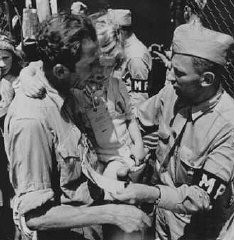
Secretary of Labor Frances Perkins testifies before the House Committee on migrant workers. Washington D.C., December 1940.

Holocaust survivor Frank Liebermann has a conversation with his teddy bear. Germany, 1933–35. On Frank Liebermann’s first day of school in Gleiwitz, Germany, in 1935, he reported to one of the few small classrooms set aside for Jews. After school, he rushed home to avoid antisemitic attacks. In 1936, it got worse. Anti-Jewish laws now banned Frank from playgrounds and swimming pools. The family decided it was time to leave and applied for US visas. They were lucky. In October 1938, the…
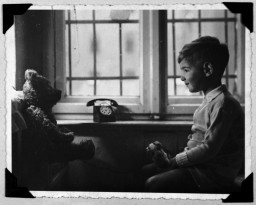
President Franklin D. Roosevelt sits with Eleanor Roosevelt in his study in the White House. FDR was elected the 32nd president of the United States in the presidential elections of November 1932. Washington, DC, 1933.
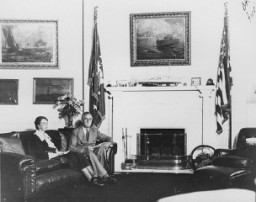
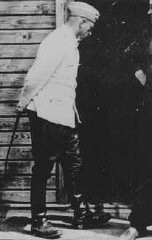
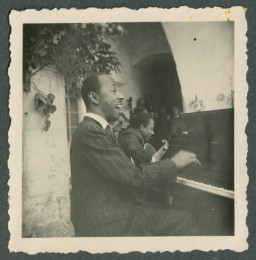
(1941-1942) Crowded newsstands in the United States such as these held journals representing various political parties and ideologies. Americans had access to many different perspectives about what was happening at home and abroad during the war.
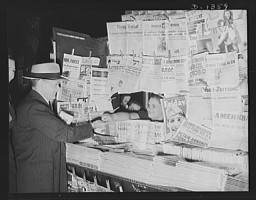
A French army ambulance during World War I. This photograph was taken ca. 1914–1915.
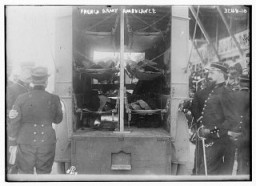
French General Charles de Gaulle and resistance leader Georges Bidault confer before marching down the Champs-Elysees to Notre Dame in ceremonies marking the liberation of the French capital. Paris, France, August 1944.
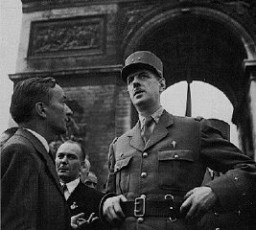
French government announcement concerning antisemitic legislation. Paris, France, December 10, 1941.
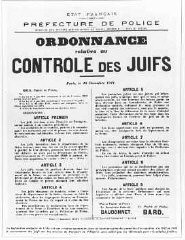
French leader Charles de Gaulle in London after France signed an armistice with Germany on June 22, 1940. De Gaulle refused to accept the armistice and led the Free France resistance movement. London, Great Britain, June 25, 1940.
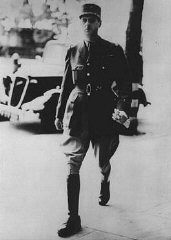
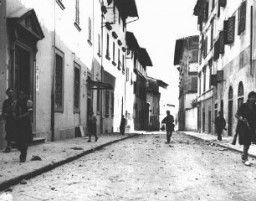
French police check the identity cards of pedestrians during the roundup of Jews on the Boulevard Voltaire (near the Place de la Republique) in Paris, France, August 20, 1941.
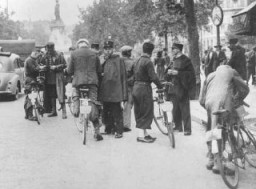
Like many editions of The Protocols of the Elders of Zion published in the 1920s, this French-language version charges that Jews are a foreign and dangerous influence. Published in Paris, 1920.
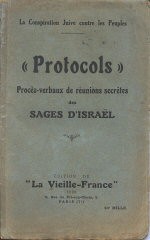
“For three months I was disguised as a man, and very successfully… I passed my mother several times … she never recognized me.” Frieda Belinfante, a half-Jewish lesbian, used this disguise to hide from Nazi authorities. In a later interview she said, “I really looked pretty good.” Her involvement in the resistance movement included planning the destruction of the Amsterdam Population Registry in March 1943, falsifying identity cards, and arranging hiding places for those who were sought by…
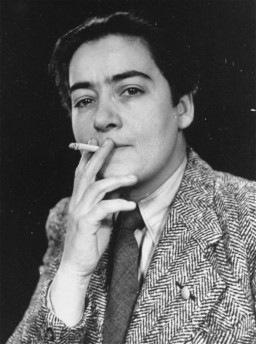
A hand-tinted photograph of Frieda Greinegger and Julian Noga as a young couple. The two had met when Julian, a forced laborer from Poland, arrived at the Greinegger farm in northern Austria. In 1941, the Gestapo sent both to concentration camps after learning of their forbidden friendship. Place uncertain, after 1945.
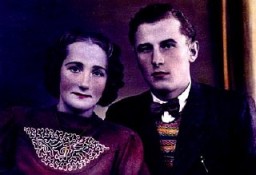
Friedrich Mennecke, a Euthanasia Program physician who was responsible for sending many patients to be gassed. He was sentenced to death in 1946. Germany, date uncertain.
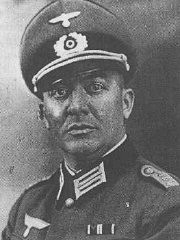
Fritz and Ida Lang, Jewish proprietors of a dry goods store in Lambsheim, posed for this picture around 1934. In the early 1940s, Nazi authorities deported the Langs and their young daughter, Freya, to detention camps in France. Ida died after deportation to Auschwitz. Fritz survived and reunited with his daughter in 1946. Lambsheim, Germany, ca. 1934.
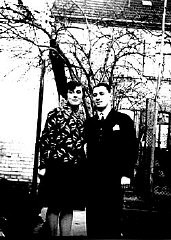
Fritz Glueckstein (left) on a picnic with his family in Berlin, Germany, 1932. Fritz's father was Jewish—he attended services in a liberal synagogue—and his mother was Christian. Under the Nuremberg Laws of 1935, Fritz would be classified as mixed-raced (Mischling), but since his father was a member of the Jewish religious community, Fritz was classified as a Jew.
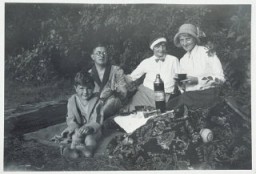
Fritz Kuhn, head of the antisemitic and pro-Nazi German American Bund, speaks at a rally. United States, between 1936 and 1939.
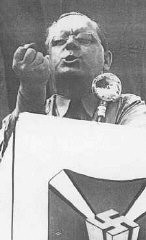
Front page of the most popular issue ever of the Nazi publication, Der Stürmer, with a reprint of a medieval depiction of a purported ritual murder committed by Jews.
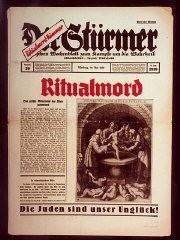
In February 1929, the Nazi newspaper "Der Stuermer" depicted a caricature of Magnus Hirschfeld. The Nazi Party attacked Dr. Hirschfeld for his ideas about sex, sexuality, and gender, as well as his Jewish ancestry.
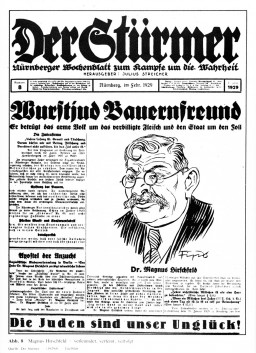
SS officer Karl Höcker salutes in front of an array of wreaths during a military funeral near Auschwitz. The original caption for the photograph reads "Beisetzung von SS Kameraden nach einem Terrorangriff." (Burying our SS comrades from a terror attack.) Pictured in the background are Josef Kramer and Karl Moeckel.This image shows the aftermath of the September 13, 1944, bombing of IG Farben in which 15 SS men died in the SS residential blocks and 28 were seriously wounded.
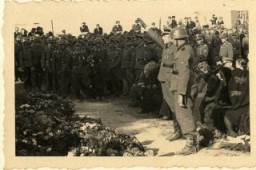
After the liberation of the Wöbbelin camp, US troops forced the townspeople of Ludwigslust to bury the bodies of prisoners killed in the camp. This photo shows US troops assembled at the mass funeral in Ludwigslust. Germany, May 7, 1945.

After the liberation of the Wöbbelin camp, US troops forced the townspeople of Ludwigslust to bury the bodies of prisoners killed in the camp and give the victims a proper burial. This photograph shows the funeral for the victims. Germany, May 7, 1945.
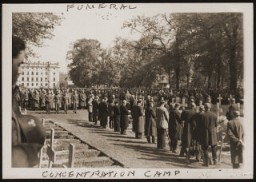
We would like to thank Crown Family Philanthropies, Abe and Ida Cooper Foundation, the Claims Conference, EVZ, and BMF for supporting the ongoing work to create content and resources for the Holocaust Encyclopedia. View the list of donor acknowledgement.